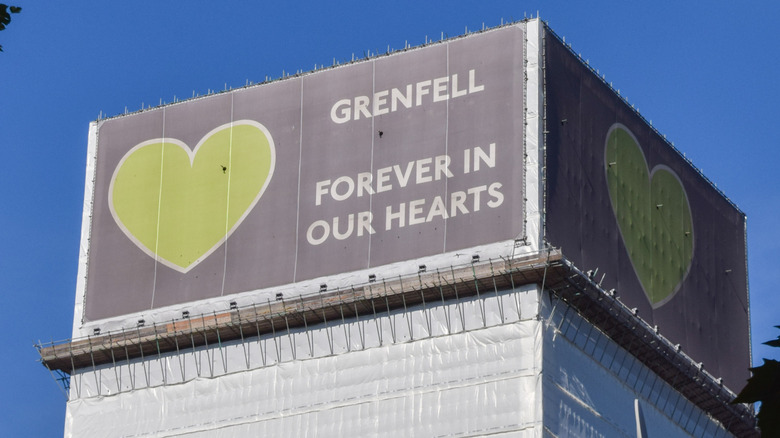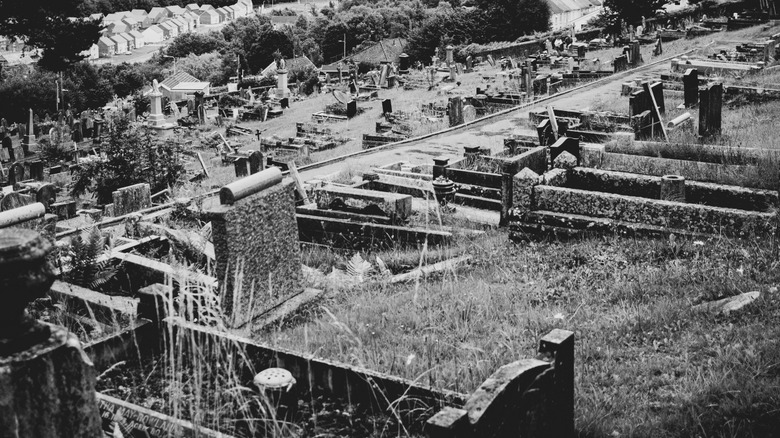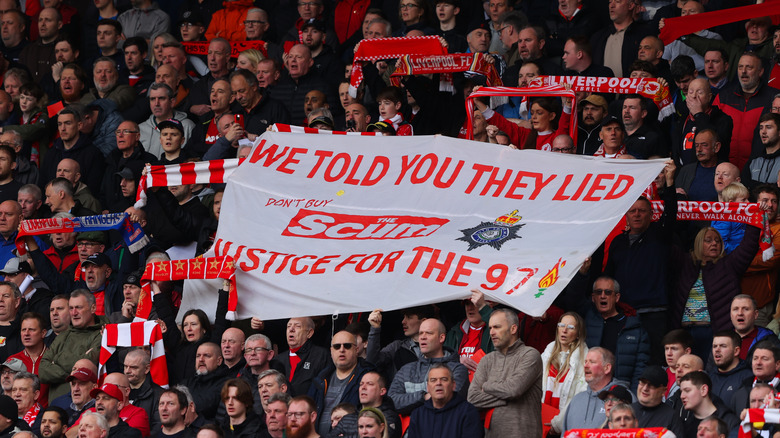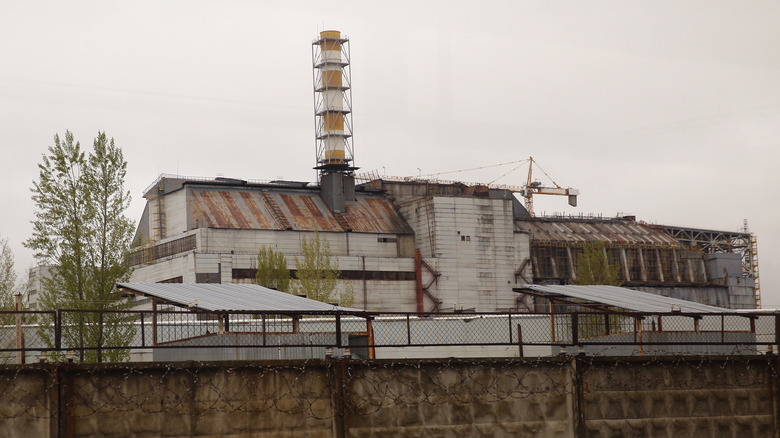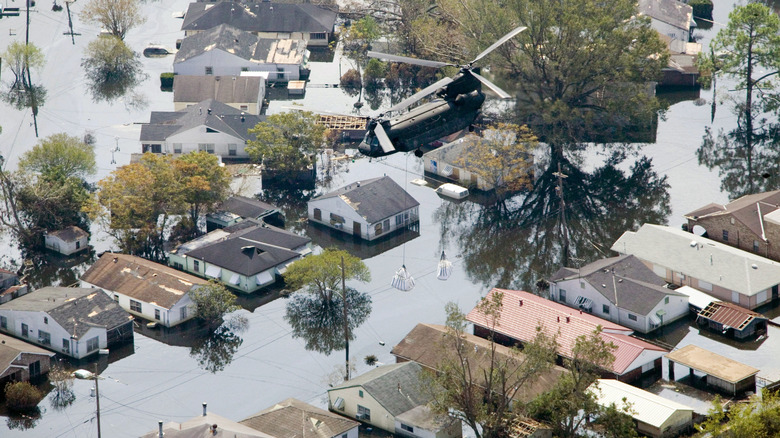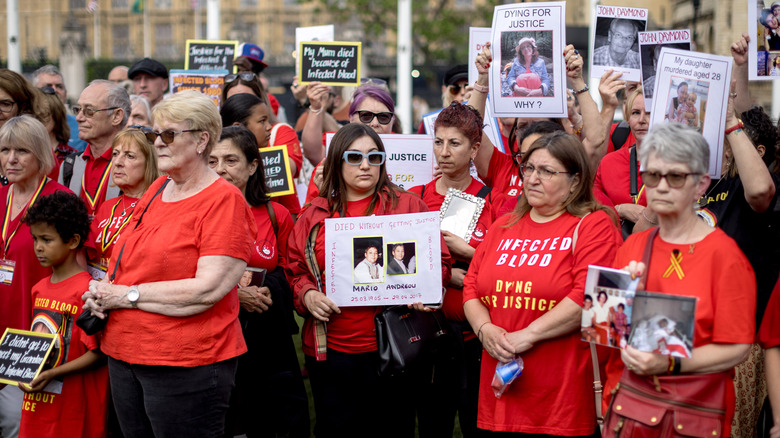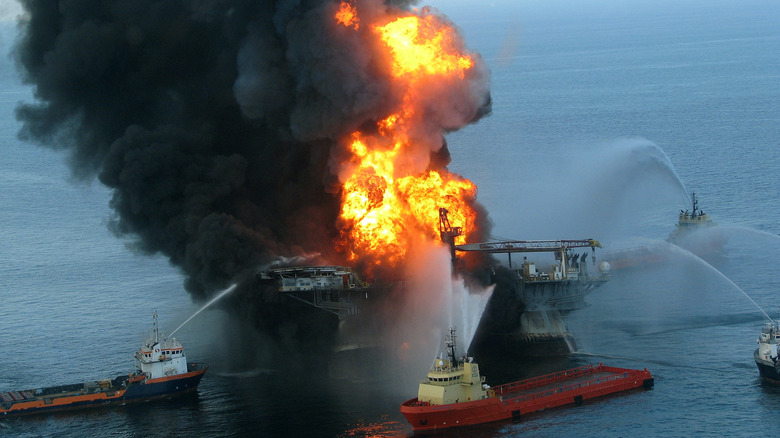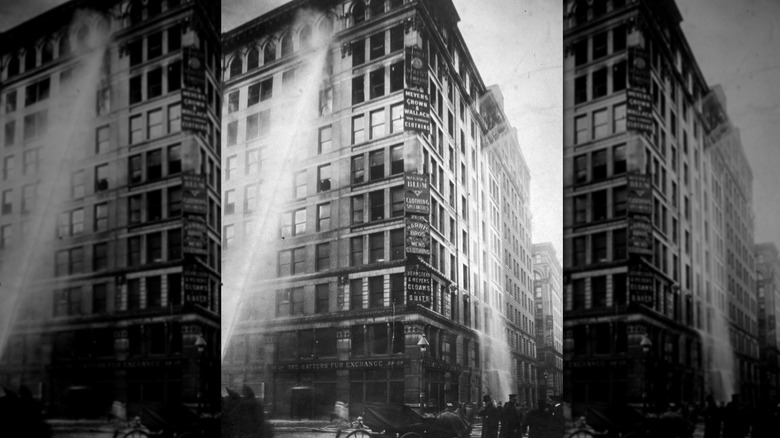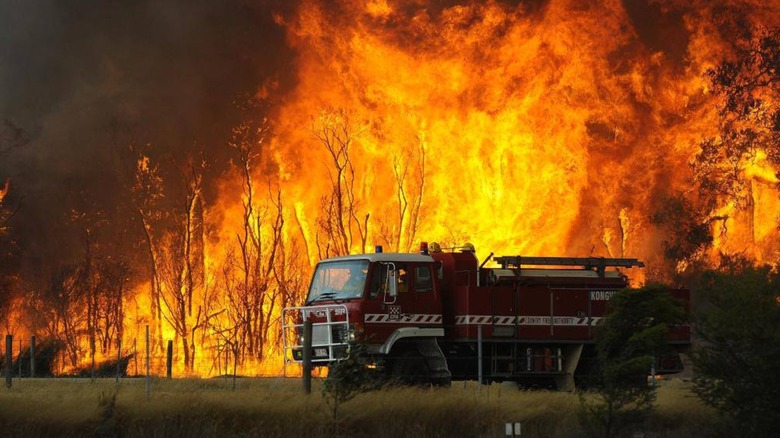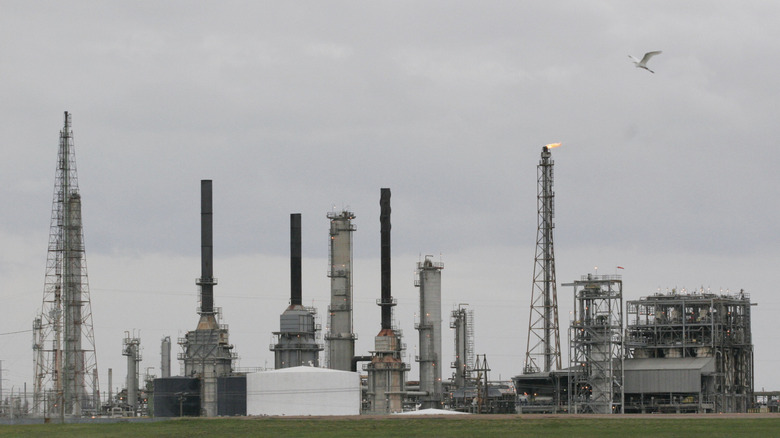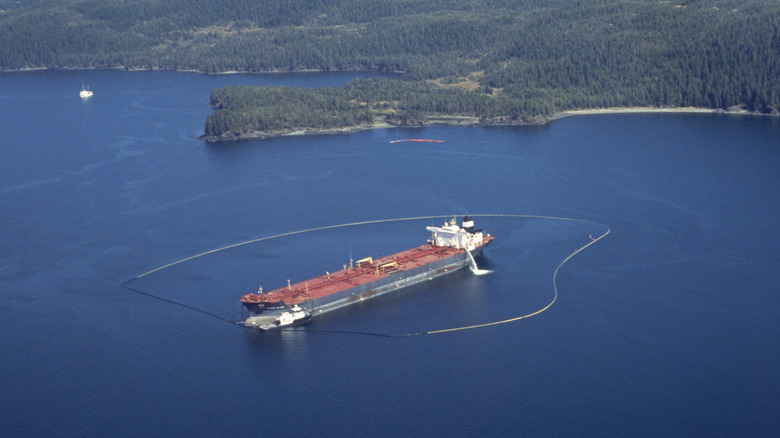Scandals That Rocked These Infamous Events
We may receive a commission on purchases made from links.
History is littered with tragic incidents and shocking events. In years gone by, we would devour every piece of information about them in the newspapers. But in the digital age, these events dominate the news cycle for a few days or weeks before our interest in the stories fades and we move on. Sometimes the causes are immediately obvious, and the finger of blame can be pointed at an individual or organization, and justice is served.
Sometimes it takes longer for the causes behind them to emerge, shedding light on details that can often be more shocking or outrageous than the event itself. Cover-ups and lies, individual, corporate, and government negligence, and corner-cutting have all played their role in a slew of lethal accidents, environmental disasters, and tragic incidents that hit both national and international headlines. In some cases, their effects are still being felt to this day. Here's a rundown of the scandals that rocked these 12 infamous events.
The Aberfan disaster
At 9:15 a.m. on October 21, 1966, over 793 million pounds of colliery waste, piled 500 feet above the Welsh village of Aberfan, began to move after weeks of rain. Quickly gathering speed, it roared down the mountainside, flattening a farmhouse before slamming into Aberfan's Pant Glas Junior School and 18 houses. Within hours, 144 people, including 116 children, were dead.
That morning, Lord Alf Robens, chairman of the National Coal Board (NCB), attended a ceremony at the University of Surrey, but NCB officials told the Welsh government he had been overseeing the rescue efforts. Per the BBC, when he did arrive in Aberfan, he told the press it was "impossible to know that there was a spring in the heart of this tip." But everyone knew about it, and despite warning letters written in the 1950s, as well as slips in 1943 and 1963, the NCB had never done anything to reduce the danger.
In 1967, a tribunal of inquiry said the disaster was "a terrifying tale of bungling ineptitude by many men charged with tasks for which they were totally unfitted." Despite the scathing conclusion, nobody was prosecuted or even fired. The Aberfan Disaster Fund raised over $2.3 million, and though some of it was intended to pay for the tips to be removed, the NCB refused. Devastated parents were offered £50 (around $67) as compensation, a figure that eventually increased to £500 (around $664).
The Hillsborough disaster
The 1989 FA Cup semi-final between Liverpool and Nottingham Forest should have been a great day out at the soccer game. It turned into a deadly stadium disaster that unfolded on live TV, as thousands of people were crammed into one end of Sheffield Wednesday's Hillsborough stadium. The resulting crush injured more than 700 people and killed 97, prompting a fight for justice that ran for more than 30 years.
The Sun newspaper falsely claimed Liverpool fans pickpocketed the dead, per the BBC, and bolstered South Yorkshire police's lie, picked up by the media, that ticketless fans were responsible for the lethal crush. Superintendent David Duckenfield, who had no experience of overseeing such a sporting event, told FA officials that supporters had forced a gate that he had earlier ordered to be opened. In 1990, the Crown Prosecution Service decided there was not enough evidence to bring a case to court, and, a year later, an inquest reached a verdict of accidental death for all the victims.
In 1997, it emerged that police officers' statements about what happened at Hillsborough were unlawfully changed, but there was no attempt to overturn the verdict. Finally, in 2016, a fresh inquiry concluded all 97 victims were "unlawfully killed due to gross negligence manslaughter." The Liverpool fans were exonerated, and the finger of blame now pointed at South Yorkshire police — and Duckenfield. He was tried in 2019 and found not guilty, while the men accused of changing police statements were acquitted in 2021.
The Chernobyl disaster
On April 26, 1986, an explosion took place during the testing of the Number Four reactor at the Chernobyl plant near Pripyat, Ukraine. The blast threw radioactive elements, including strontium and caesium, across 58,000 square miles, covering Ukraine, Belarus, and Russia. At the time, regional official Vladimir Malomuzh said that "everything in Pripyat should carry on as usual," according to Adam Higginbotham's book "Midnight in Chernobyl."
Three days later, after Swedish authorities detected high radiation levels across Europe, Russia finally acknowledged the event. Subsequent reports revealed a litany of failures behind one of the world's worst nuclear disasters, including the "flawed" reactor design, which did not include a suitable containment structure. The documents also noted that untrained staff carried out the test on reactor No. 4, bypassing procedures to get the assessment done quickly, possibly due to external pressure from management.
Official figures said 31 people died, 600,000 people involved in cleanup operations faced high radiation levels, and over 8.4 million people were exposed. However, the social impact was far more damaging. Misconceptions about radiation poisoning led to what The Chernobyl Forum report called a "culture of chronic dependency" and a "paralyzing fatalism," per the World Nuclear Association. An estimated 1 million abortions were carried out after Chernobyl, based on incorrect medical advice.
Hurricane Katrina
Between August 23 and 29, 2005, a tropical depression in the Bahamas evolved into Hurricane Katrina, a category 4 system that hit Louisiana, New Orleans, and Mississippi. It brought winds of over 170 miles per hour, while the storm surge, recorded at 28 feet in some places, led to catastrophic flooding in New Orleans after man-made levees collapsed. More than 1,833 people were killed, millions were left homeless, and the damage was estimated at $161 billion.
Although states of emergency were declared in Mississippi and Louisiana days earlier, New Orleans Mayor Ray Nagin waited until Sunday, August 28, to order an evacuation. Thousands who did not leave rushed to the city's Superdome, which quickly became a "hellhole," according to The Seattle Times. Slow, uncoordinated, and confused actions at the state and federal level saw thousands of stranded people lacking basic necessities and the recovery of bodies delayed.
That botched response could have been prevented. In Donald P. Moynihan's report "The Response to Hurricane Katrina," he cited a FEMA that was "weakened" by the appointment of inexperienced officials with a lack of understanding about the scale of the disaster, despite earlier predictive models. In February 2006, a House of Representatives' report criticized everyone from President George W. Bush and FEMA to officials who ignored warnings from the National Hurricane Center and the National Weather Service.
The infected blood scandal
The treatment of people with hemophilia and other blood clotting disorders was revolutionized in the United Kingdom during the 1970s with the introduction of factor concentrate. But this medical marvel is now regarded as the biggest treatment disaster in NHS history. Factor concentrate was created from tens of thousands of plasma donations, sometimes from overseas. Across two groups of patients between the 1970s and 1991, over 30,000 people were unknowingly infected with HIV and hepatitis C via contaminated concentrate. Some unwittingly passed both diseases onto their loved ones, and it is believed that almost 3,000 people have died.
In 2024, the five-year Infected Blood Inquiry concluded that the medical profession and successive U.K. governments were to blame for the scandal. Chairman Sir Brian Langstaff said the disaster "was not an accident" and criticized the "institutional defensiveness" of medical staff and civil servants," via the BBC. The Inquiry found that not enough was done to prevent imported, infected blood or that of high-risk domestic groups such as prisoners, and that "downright deception" had hidden the truth for years. In 2025, the government said "substantial changes" would be made to the victims' compensation scheme to enable payouts to those who have already died.
The Boston molasses flood
In 1915, the United States Industrial Alcohol (USIA) installed a 50-foot-high, 90-foot-wide molasses tank in Boston's North End, home to an Italian immigrant community. Almost immediately residents began complaining of leaks from the tank, but they were ignored. It remained in use until January 15, 1919 when — having been filled almost to the brim — it burst.
Around 2.3 million gallons of molasses, moving at around 35 miles per hour, flooded the region for several city blocks, killing 21 people and injuring roughly 150. The cleanup and recovery of bodies took weeks and was followed by a class action lawsuit against the United States Industrial Alcohol Company. While almost 120 plaintiffs pointed out the poorly made tank, USIA tapped into the isolationist, xenophobic politics of the time to claim Italian anarchist groups had blown it up.
According to Amanda Tuttle, writing for Old North Church, there had been two bombings in the area in the years before. Boston Police also believed the region was a hotbed for Italians "preaching the violent overthrow of capitalism and government." However, after a five-year investigation, a state auditor ruled that errors and oversights by USIA were entirely to blame for what became known as the Great Molasses Flood.
The Grenfell Tower fire
How did a kitchen fire in a West London tower block turn into one of the United Kingdom's worst disasters, killing 72 people? In the early hours of June 14, 2017, firefighters took a 999 call from Grenfell Tower in North Kensington. Within minutes of their arrival, flames had ignited the building's exterior cladding. It quickly spread around the tower, and by 4:30 a.m., the outside was on fire, including over 100 apartments. The "stay put" order keeping people in their homes, which experts said had failed within 30 minutes of firefighters arriving, was not lifted until 2:47 a.m.
While a public inquiry revealed the human cost of the fire, it took until 2024 for the mistakes, lies, and negligence behind it to fully come to light. It emerged that the cladding used on the building was highly flammable, and countries including the United States had banned its use in tall buildings. French manufacturer Arconic also knew the material failed standard European fire tests, but it did not submit it to specific English tests and misled the British standards board.
The Royal Borough of Kensington and Chelsea and the Kensington & Chelsea Tenant Management Organisation, authorities that oversaw Grenfell, opted for the cladding to cut the cost of building renovations — despite tenants' concerns and a similar incident in 2009. It is believed that around 11,000 buildings across the U.K. are still covered in dangerous cladding.
The Deepwater Horizon disaster
The challenging Macondo oil well in the Gulf of Mexico was already nicknamed "the well from hell" before an attempt to seal it failed on April 20, 2010. Pressurized methane gas rose to the Deepwater Horizon oil rig platform, owned by Transocean and leased by BP, where it caught fire and exploded, killing 11 men. After burning for two days, the rig sank, while almost 5 million barrels of oil leaked into the Gulf of Mexico for around 12 weeks. The largest marine oil spill in history impacted around 1,100 miles of coastline and cost over $42 billion to clean up.
Several investigations sought the cause of the catastrophic man-made disaster, revealing failures at multiple levels. The Deepwater Horizon oil rig had operated for years with no issues, and its crew was highly regarded in their field. Both factors contributed to BP and Transocean normalizing increased risk, while the team did not follow proper technical processes for sealing the well, and minor warning issues were overlooked.
In 2014, two years after accepting criminal responsibility and agreeing to a civil settlement, collectively costing more than $13 billion, BP was found grossly negligent. The company agreed to pay $20.8 billion to the U.S. government and states, of which $15.3 billion would be written off as a tax deduction. In addition, BP's landmark deal with cleanup workers was a false promise, with many receiving just $1,300, and thousands of legal cases were dismissed.
The Triangle Shirtwaist fire
Around 500 employees were nearing the end of their shift at New York City's Triangle Shirtwaist Company on Saturday March 25, 1911 when a fire broke out. It lasted 18 minutes and killed 146 people. Many perished in the deadly blaze, while others leapt to their deaths from the ninth floor of the burning building, despite the efforts of people on the ground to catch them. The overloaded fire escape broke and collapsed, while the city's fire truck ladders only reached the sixth story.
Survivors confirmed the factory doors were regularly locked to prevent stealing, and the elevator car only made a single trip down after the fire began. In the immediate aftermath, business owners Max Blanck and Isaac Harris said the building was fireproof, yet investigations revealed it was not. It also lacked fire escapes and adequate exits. The pair were tried for manslaughter in a case that hinged on whether they knew the door was locked. The jury found them not guilty.
Although the Triangle Shirtwaist fire helped catalyze important change, Blanck did not follow suit. In August 1913, he was fined $20 for locking the doors to his factory during work hours, and in December, Blanck received a "stern warning" after rubbish was found piled several feet high in flammable wicker baskets on the factory floor, per Cornell University.
The Black Saturday bushfires
The heatwave of 2009 saw temperatures reach over 115 degrees Fahrenheit in Melbourne by the end of January. Australia's dry Christmas holiday left the state of Victoria vulnerable to the risk of bushfires. On February 7, a storm downed power lines in Kilmore East, starting the first of what became 400 fires that killed 173 people and around 1 million animals, burned over 450,000 hectares, and destroyed thousands of properties.
Less than two months after "Black Saturday," it emerged that the government failed to hit controlled burning targets, which could have reduced the impact of the February bushfires. More shocking were revelations about AusNet Services. In 2015, the state coroner determined that the power company's equipment started the Murrindindi-Marysville bushfire, it was substandard, the risk of it failing was "foreseeable," and the power line's design was altered after Black Saturday. All of this contradicted a previously agreed-upon $300 million no-fault class action settlement (via The Age).
Ten years after Black Saturday, an article in the University of Melbourne's Pursuit noted that lessons had still not been learned. Australia was struggling to control urban sprawl and respond to incidents of arson, and it was also failing to adapt to one of humanity's most important issues. "The greatest failure to learn from the Black Saturday fires has been the lack of response to climate change," the article said.
The BP Texas City disaster
Fifteen people died and 180 were injured in one of the worst industrial accidents in the history of the United States. But the explosion at BP's Texas City refinery in March 2005 was caused by a catalogue of failures in safety management. It happened after a raffinate splitter tower was filled to 15 times the usual level during the restart of a hydrocarbon isomerization (ISOM) unit. When liquid entered the vapour line, it overflowed a blowdown drum, creating a cloud of vapor that was ignited by a backfiring truck.
Two years later, the U.S. Chemical Safety and Hazard Investigation Board (CSB) revealed the full extent of the errors that led to the fatal explosion. They included a wrongly calibrated tower level indicator, a lack of trained, adequately rested staff overseeing the restart process (particularly at the most dangerous time), poor communication at all levels, and ineffective procedures. A 2006 report from the Institution of Chemical Engineers cited similar issues and noted that previous audits had "generally failed to identify the systemic problems with work practices." In 2025, the CSB published an update on the Texas City disaster, revealing that only one of the 26 safety recommendations it made was outstanding, adding that "more still needs to be done to protect workers and communities."
The Exxon Valdez oil spill
Alaska's Prince William Sound is the site of one of the worst man-made disasters in the United States. In 1989, the Exxon Valdez tanker ran aground on a rock at nearby Bligh Reef, spilling 11 million gallons of crude oil. According to the Prince William Sound Regional Citizens' Advisory Council, formed after the spill, roughly 1,300 miles of shoreline were polluted, and thousands of creatures, including eggs, seabirds, and whales, were killed.
Investigations revealed Captain Joseph Hazelwood changed the tanker's course outside the standard shipping route before handing over control to the third mate. Hazlewood was later found to have been drinking before the handover and was in bed at the time of the grounding. The third mate was both underqualified and sleep-deprived, the Valdez was under-crewed, and the radar had not worked for over a year. In addition, Exxon had not fitted the ship with iceberg monitoring equipment.
The initial response to the spill was slow, despite good conditions for oil recovery. A lack of equipment, Exxon's "designated responder" boat stuck in dry dock, and confusion over how to remove the oil meant nothing happened for the first three days. Even worse, when it began weeks later, the cleanup did more harm than the original spill. In 1991, Exxon Corporation and Exxon Shipping Company agreed to pay a $900 million settlement and pled guilty to federal environmental criminal charges. Oil pollutes Prince William Sound to this day.
